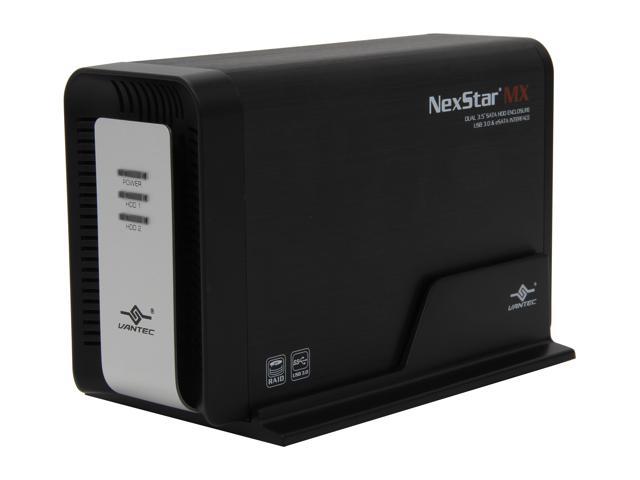Download Vantec Nst-225mx-s3 Jmicron Hw Raid Manager For Mac
Welcome to the second part of the review on the Orico USB 3.0 5-bay RAID HDD Enclosure where we continue with actual performance tests and usage experiences. Performance Testing The drive itself presented as a single drive as I was using it in RAID0 mode. The drive appears to present itself as 512 byte sectors, although the internal RAID format was not determined. Should the controller itself fail, retrieving the data may pose a small challenge as with most hardware RAID devices. Platform 1 As supplied, the unit was first tested with the NEC Renesas USB 3.0 controller on the Gigabyte 890FXA-UD7 with AMD Phenom II X6 1090T @ 3.90Ghz running Windows 7.
This is my regular workstation, and the one which most devices are tested with. As supplied, the HD Tune Pro sequential read shows an average 182MB/s read speed which is stable across the unit. This is better than a GbE connected NAS (~110MB/s) but a lot less than what is potentially possible if UASP capable chipsets and SATA III connections were used internally. Writes posed a slightly less but similar speed of 172.7MB/s. As I was mainly interested in sequential performance, I did not explore the performance of the array under other benchmarks. A check of the drive took over 33 hours but showed perfect data integrity but at a lower speed of 159MB/s – just 1MB/s shy of the requirement.
This makes it a bit of a close shave. Platform 2 I tried to test the unit with my second platform, my Z97-based system with an i7-4770k @ 3.90Ghz running Windows 7. This utilizes the, for which the latest drivers (4.0.0.36) were installed. It was here that a big problem began to arise. Accesses to the RAID array from this platform were impossible to reliably perform, and instead, the drive will have errors of some sort after a random amount of time, often just a few minutes or less. It didn’t matter the benchmark, or the tool used.
Dual 3.5' SATA to USB 3.0 and eSATA With JBOD/RAID 0/1 External Hard Drive Enclosure. Vantec NexStar® MX Dual Bay External HDD Enclosure now in the USB 3.0 and eSATA interface is a quick and simple way. 4 Channel 6-Port SATA 6Gb/s PCIe RAID Host Card / UGT-ST644R 3-Port USB 3.0 Type A/C PCIe Host Card / UGT-PC331AC 4-Port SuperSpeed USB 3.0 PCIe Host Card w/ Internal 20-Pin Connector / UGT-PC345. 4 Channel 6-Port SATA 6Gb/s PCIe RAID Host Card / UGT-ST644R 3-Port USB 3.0 Type A/C PCIe Host Card / UGT-PC331AC 4-Port SuperSpeed USB 3.0 PCIe Host Card w/ Internal 20-Pin Connector / UGT-PC345.

Jmicron Hw Raid Manager
The event log appears to show that trouble was indeed experienced. It appears this is the curse of the Jmicron. Jmicron chipsets appear to have problems with certain USB 3.0 controllers, namely including the Intel ones. Other people have also experienced such issues from a with with varying levels of acknowledgement including outright denial of problems, and varying levels of “do-it-yourself” solutions. Sadly, it seems this issue is real and endemic to this particular chipset. Platform 3 This was my daily use laptop, a Lenovo E431 with i7-3630QM CPU running Windows 10. Because this unit is based on the C216 chipset platform, it has a subtle difference, and surprisingly the drive was able to pass (95% of) the H2testW as supplied (before a stray projectile aborted the test) when used with the C216 platform.
This may be the reason why there are inconsistent reports of Intel chipset and Jmicron compatibility issues. Summary The unit’s performance was better than a GbE NAS, but still fell way behind the theoretically available performance of the USB 3.0 bus under ideal conditions, and even under practical conditions as revealed by SSD-in-enclosure experiments. The Jmicron chipset was especially troublesome with Intel C220 platform USB 3.0 controllers (used in 4th Generation Intel CPUs and newer), refusing to function correctly even with the latest drivers, but worked with the C216 platform and the NEC Renesas chipset in my other computers. Compatibility with Fresco Technology, Etrontech, Asmedia, etc chipsets were not determined but from other reports, it appears that Jmicron chipsets cause problems with some of these other chipsets. This issue practically makes the unit unusable with a vast majority of users of modern computers. A Jmicron Cure?
Disclaimer: Undertaking any of the following steps will void your warranty and may lead to permanent damage to your device resulting in an inoperative device with no possibility of recovery. Do the following at your own risk. Upon doing some research, some people had claimed that by updating the firmware of the unit, that they could get their USB hard drive docks, etc. Performing reliably.

A search landed me at the of Jmicron firmware and tools which I could try. Many of the firmwares available are just bare files, and so, to flash the firmware, you need to use the JMicron JM2033x FW Update Utility v1.19.13. Download utorrent for mac free. Before updating the firmware, I tried to be diligent and back-up the existing firmware. While it claims to have succeeded, I have since found that the file created cannot restore the original firmware to the device, and so I have lost the original firmware forever. Initially I was unaware of the difference between JMS539 and JMS539B, so I had assumed the device to be a JMS539 and attempted a flash of JMS539_PM v255.31.3.41.22 while ignoring the warning of incompatible firmware only to result in the device to reconnect as “Internal Code”. This in itself is a revelation as it indicates the unit has realized that the firmware is incorrect and instead is running off its internal Mask ROM. This is the basic “known good” firmware that is burnt into the chip as a fallback for vendors who want to save the money on a serial flash chip and not provide firmware-upgrade capabilities, or customized names.